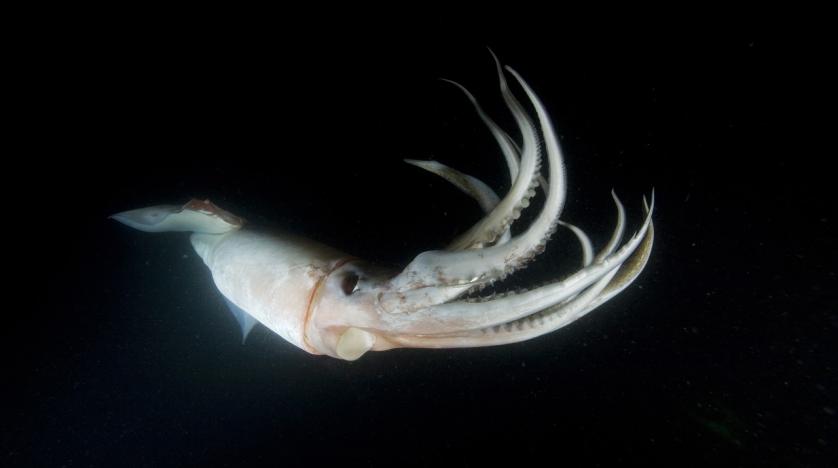Fossil Uncovers 200 million-Year-Old 'Deadly Embrace'

Asharq Al-Awsat
About 200 million years ago, a brutal underwater attack took place in the Atlantic. A squid-like creature, armed with 10 tentacles studded with hooks, swam up to a prehistoric fish. The predator wrapped its long arms around the fish's head and crushed its skull.
The cephalopod was looking for a quick, delicious bite, but the meal cost the creature its life. Predator and prey died in a deadly embrace, and their interlocked bodies were fossilized under the waves.
A new study analyzing that fossil, which has been accepted for publication in Proceedings of the Geologists' Association, suggests this is the oldest evidence of such a squid attack ever found. Malcolm Hart, a paleontologist at the University of Plymouth and the study's lead author, said fossils depicting one animal preying on another are exceedingly rare.
"It points to a particularly violent attack, which ultimately appears to have caused the death, and subsequent preservation of both animals as a fossil for the coming generations," he said in a press release published on the university's website.
Although the fossil was originally discovered in the 19th century off the southern coast of the UK, Hart decided to reexamine it after recently seeing it on display in a British museum. He wanted to know precisely what was going on in the ancient rock tableau and when it had happened. Hart and his colleagues determined that the predator in question was a16-inch-long (40-centimetre) coleoid, a type of squid ancestor, while the 8-inch-long (20-centimeter) prey was an extinct fish that lived in the early Jurassic age in Europe.
The researchers said the fossilized position of the squid's arms, ensnaring the fish's head and body, suggests that the two animals died together, rather than perishing separately and then being preserved together. This isn't the first coleoid fossil found in the UK, according to Hart, but it is the oldest.
His team dated the fossil to be between 190 and 199 million years old, which predates the next-oldest fossil depicting a coleoid attack by 10 million years.
In their study, the researchers offer two guesses as to why the cephalopod met its doom instead of satiating its hunger. One hypothesis is that the fish was simply too large for its attacker, and eventually, the pair sank to the seafloor together. They also suggested that the greedy cephalopod, after biting down on its hapless prey, purposefully sunk down to deeper waters to avoid other predators.
Latest News
 King orders holding parliamentary elections in accordance with law, checks on electoral commission’s preparations
King orders holding parliamentary elections in accordance with law, checks on electoral commission’s preparations- N. Macedonia starts elections that could decide stalled EU talks
 US Senate passes bill for aid to Israeli Occupation, Ukraine, Taiwan
US Senate passes bill for aid to Israeli Occupation, Ukraine, Taiwan Safadi discusses support to Syrian refugee with DRC
Safadi discusses support to Syrian refugee with DRC Israeli Occupation aggression on Gaza enters 200th day
Israeli Occupation aggression on Gaza enters 200th day
Most Read Articles
- US president signs bill to provide new aid for Ukraine
- Prime minister directs government to support IEC ahead of upcoming elections
- Palestinian prime minister, Jordanian ambassador discuss humanitarian efforts in Palestine
- US Supreme Court seems split on Idaho abortion ban
- UAE announces $544m for repairs after record rains
- Germany nudges up growth forecast, ailing economy at 'turning point'
- Four dead as floods wreak havoc in Kenyan capital
- Iran cuts Syria presence after strikes blamed on Israel —monitor
- Vaccines saved at least 154 million lives in 50 years — WHO
- Israel pummels Gaza after US Congress approves military aid